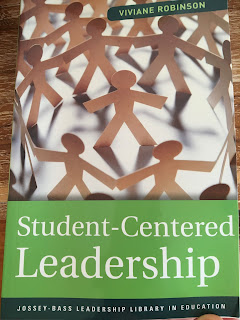Student-Centred Leadership by Viviane Robinson
Student-Centred Leadership by Viviane Robinson
A solid leadership book, like much of the Edu Leadership
writing landscape she leans quite heavily on Marzano and Hattie’s
Meta-meta-analysis, if you don’t put too much stake into these two scholars
work you will likely find some elements of this book a challenge. Indeed, the
five elements she explores are based around ‘effect sizes’, so her entire book
is intrinsically tied to the meta-meta-analysis or meta-analysis approach,
something that is being increasingly challenged within the educational
literature.
Putting that minor point aside, she provides a strong case
for different elements of leadership and explores reasonably interesting
anecdotes consistent with these themes, these anecdotes are not entertaining in
themselves but provide context and illustration to the broad umbrella ideas
being presented.
She uses references relatively sparingly, citing the majority
of key, well-known figures. When she does provide embedded quotes, these are
when the book becomes its most engaging as they often provide real teacher and
leader voice into the book, to break up the relatively dry elements of the
book.
The general thrust of the book is the five dimensions of ‘student-centred
leadership’, the goal of this form of leadership is to move beyond the simple
managing and continuation of the school and to set goals in relation to
directly improving student outcomes. She does note that this is a significant
challenge for leaders who have up until relatively recently been focused on managerial
outcomes and what is often referred to as ‘Neo-Taylorist’ ideas of educational
management. Indeed, I have argued elsewhere, that this has led many leaders
towards the desire to accept Marzano and Hattie’s work for the simple and
clearly qualitatively presented ideas that they offer to leaders now focussed
on instructional leadership.
The five practical elements are as follows:
Dimension 1: Establishing Goals and Expectations – The manner
in which setting realistic and SMART goals is explored and the focus on
learning goals at the expense of accountability goals is suggested.
Dimension 2: Resourcing strategically – Importantly and
accurately, a great deal of this chapter focusses on sensitivity to the fact
that resourcing naturally involves the hiring, firing and promotion of teachers.
Dimension 3: Ensuring quality teaching – Her contention here
is that consistency in teaching and learning is important and that this can be
achieved through a way that does not impede or challenge teacher autonomy.
Dimension 4: Leading teacher learning and development – This
is the biggest and most challenging element of the book, leaders as instructional
leaders and people actively engaged in the same professional development as
their teachers. Notably, she does not provide any awareness or knowledge of
best practice around instruction, beyond the references to other’s synthesises
of extant literature.
Dimension 5: Ensuring an Orderly and Safe Environment – This
is perhaps not something that most Australian teachers and leaders would see as
important, indeed, many of her examples seem to smack of American exemplars.
But in light of increasing violence aimed at principals and leadership in
Australia, perhaps this is something worth further consideration.
Overall, as far as leadership books go, this was dry but
very effective. The core ideas are hard to disagree with and hold weight. The
examples and vignettes were reasonably interesting and illustrative but not in the
same lead of the New York Times Bestseller list worthy books that you may be
accustomed to. The book is reasonable in length and does not drag over elements
and ideas unnecessarily. I look forward to purchasing and reading her newest
book ‘Reduce Change to increase improvement’.
Some image-worthy highlights:







Comments
Post a Comment